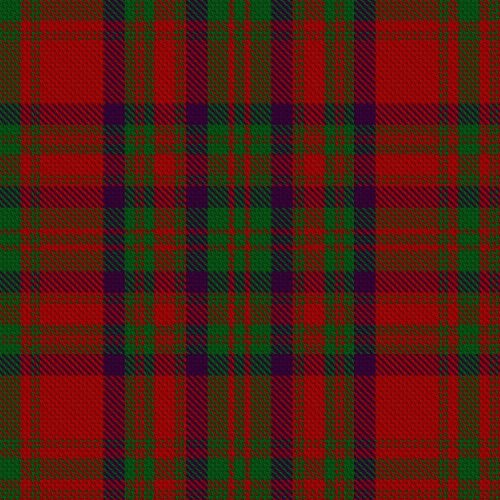What are tartans?
Though tartans didn’t originate in Scotland, they are inextricably linked with that country and particularly with the Highlands. The familiar patterns are made with alternating bands of coloured threads woven at right angles to each other. The way the threads are woven forms visible diagonal lines where different colours cross, giving the appearance of new colours blended from the original ones. The resulting blocks of colour repeat vertically and horizontally in a distinctive pattern of squares and lines known as a sett.
Matheson tartans
There are two types of Matheson tartan: the red dress tartan and the dark green hunting tartan.


For each type there are two versions: ancient and modern. Just to confuse the issue, the modern version is older than the ancient. Why? It’s understood that the ‘ancient’ version was created by weavers some time in the middle of last century to replicate what they considered the colours of the old vegetable dyes might have looked like.
The Chief of Clan Matheson reports that his family has always worn the ‘modern’ version, and this is confirmed in photographs going back to the 1870s or earlier. He advises that while people are free to choose whichever version they wish, his preference is for the modern version to be used.
Varieties of tartans
Different tartans have been ‘recognised’ by different Scottish organisations, notably the Scottish Tartans Society, the Scottish Tartans World Register and the Scottish Tartans Authority (which, despite its name, is a private organisation).
To help sort this out, in 2008 the Scottish Register of Tartans was established by the Scottish Parliament as a single, independent Scottish register of tartans that promotes and preserves information about historic and contemporary tartans from Scotland and throughout the world. It lists 10 Matheson tartans, but the ones listed as ‘Matheson dress clan/family’ and ‘Matheson hunting clan/family’ are those usually used.
Celebrating tartans
There is an international Tartan Day when everyone around the world is encouraged to wear tartan to celebrate their Scottish heritage. But it’s not as simple as that. In most countries Tartan Day is on 6 April, the date on which the Declaration of Arbroath, a declaration of Scottish independence, was signed in 1320.
But in New Zealand and Australia we do things a bit differently. For some reason that’s not clear we celebrate Tartan Day on 1 July, the anniversary of the repeal in 1782 of the 1747 Act of Proscription that banned the wearing of Highland dress including tartan in the wake of the Jacobite uprising and the Battle of Culloden.
So, whether on 6 April or 1 July (or both), show your Matheson heritage by wearing the tartan.
